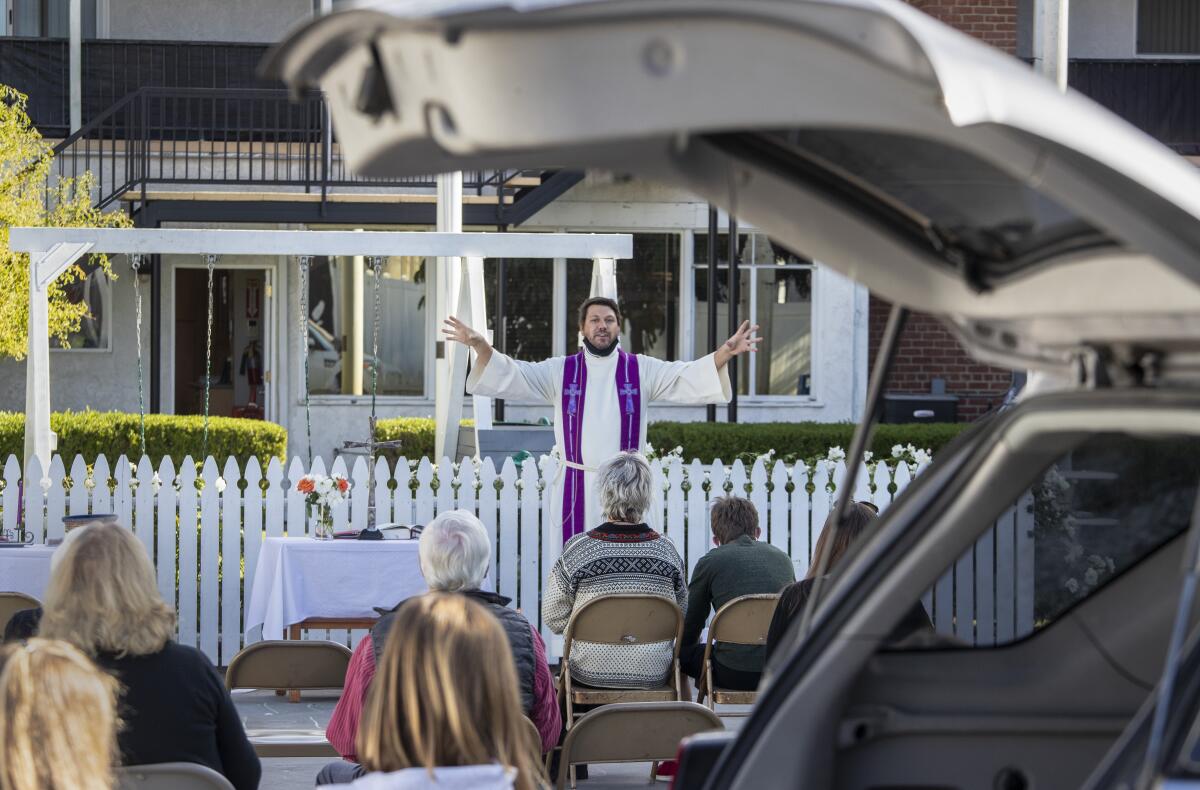Op-Ed: The church I lead was struggling — then the pandemic hit. How we’re trying to survive

- Share via
During World War II, sailors departing ships for shore leave would follow a beacon of light emanating from the steeple of San Pedro United Methodist Church. Upon arriving, they could take a shower, eat a meal prepared in our kitchen, maybe write a letter home.
History is never far away when the church you lead, and worship in, was built in 1923. It’s a grand three-story structure with beautiful stained-glass windows and a sanctuary with an open-beam vaulted ceiling that can seat 350. It’s a big church, and over time we have become a small congregation.
Decades ago, when we were the only Protestant church in town, the sanctuary filled up for both weekly services. Before the COVID-19 pandemic, we averaged about 52 people on Sunday mornings. Today about 25 parishioners gather in person, and another 100 from around the country join us online.
Since the pandemic, it has become vital for us to find ways to reinvent our ministry, to think outside the box.
Our decline in church membership mirrors a national trend. For decades, about 70% of the U.S. population belonged to a religious congregation, but a steady decline began around the beginning of the 21st century. Last year, U.S. membership in houses of worship dropped below 50% for the first time since Gallup began measuring it in 1937.
And for the first time in decades, the big red double doors in front of our church would not open for worship. We realized that our church life as we knew it would change. We could stay stagnant, and possibly slowly disappear, or change with the times.
While more than 4,000 churches in America shut their doors in 2020, we had to reframe what it means to have “open doors.” We needed to step out of our silos, and partner with other faith-based organizations and interested parties that share the common goal of supporting our community.
For inspiration, I looked back to my roots. I thought about growing up in Palmdale, watching my father, a Methodist minister, care for a family in need during the middle of the night. It reminded me of the role faith-based organizations play in society, even all these years later.
We looked for another way to be a beacon of light in the community, a solution that would pay the bills and nourish the San Pedro community. As church attendance has waned, so have contributions to churches. Thirty years ago, about 50% of all charitable contributions went to houses of worship. That figure had shrunk to about 30% by the time the pandemic struck.
One of the greatest assets many churches have is their buildings and surrounding property. San Pedro UMC is no exception. We have vast space within the church and outside it. More than 20 years ago, an empty lot next to the church was given to us. It sat vacant until we began dreaming about how it could best serve our community today.
To utilize the land, we partnered with 1010 Development Corp., a nonprofit that has been a leader in affordable housing development in Los Angeles. Our goal is to build 54 affordable housing units and provide support for those who live there. We expect to break ground by the end of this year.
It wasn’t easy during the pandemic to think of how people might use our campus in new ways when everyone needed to stay home. Still, we tried to imagine what it might be like to fill the courtyard with voices and families. Since San Pedro has a large homeless population, we decided to expand our partnership with Family Promise of the South Bay, a nonprofit that provides services to those experiencing homelessness.
The organization leased half of our building, space that includes restrooms, showers, a kitchen and gym, and classrooms. They will be used as a respite center to provide resources and support to help families get back on their feet. In February, the first residents moved in, four families that will temporarily stay with us while they work toward obtaining housing.
By renovating the same kitchen that produced those hardy meals for sailors during WWII, we will be able to develop programs to help address food insecurity in our community. During the pandemic, many people frequented food banks for the first time. Our teaching kitchen will help families learn to cook healthy meals from staples they receive from a food bank while supplementing them with produce from the farmers market. The kitchen will also be a place where people can learn a vocation.
Yes, membership in houses of worship is declining, but people who identify as spiritual — especially millennials — say they still yearn for something more. Congregations have a unique opportunity to step beyond the walls of their buildings and help change the world for the better.
Pastor Lisa Williams has led San Pedro United Methodist for seven years.
More to Read
A cure for the common opinion
Get thought-provoking perspectives with our weekly newsletter.
You may occasionally receive promotional content from the Los Angeles Times.










